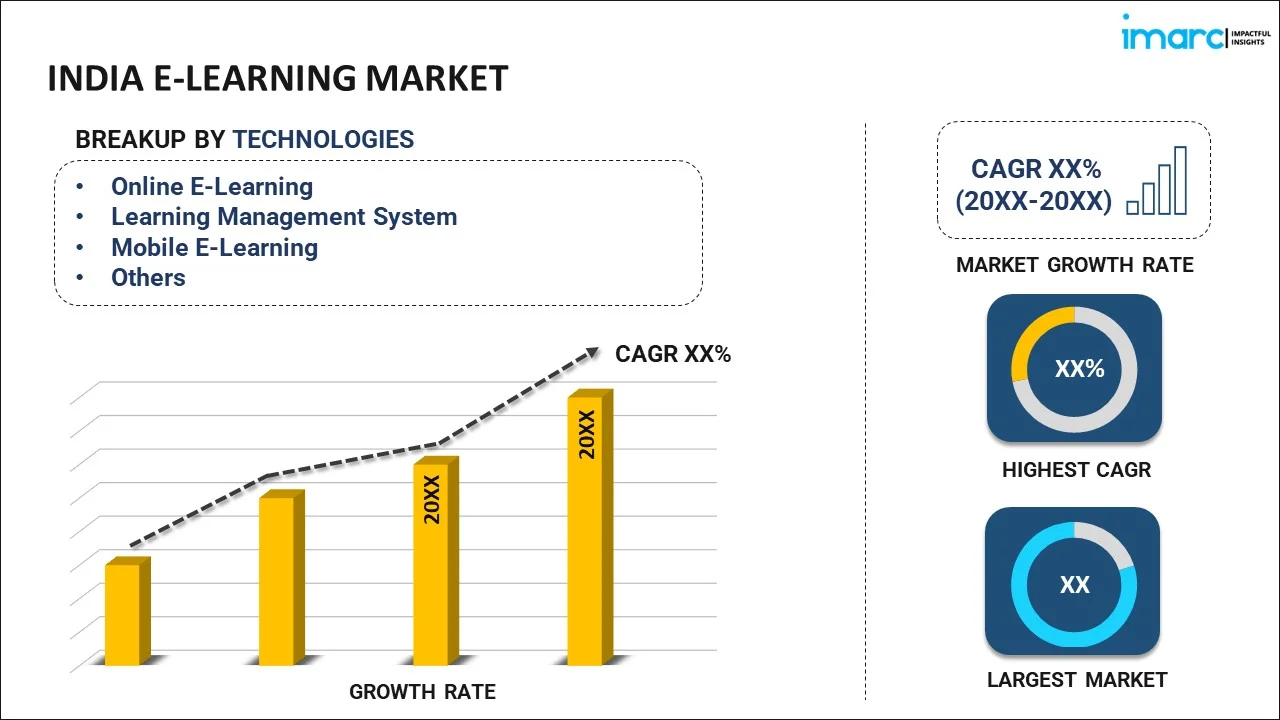
India E-Learning Market Report by Technology (Online E-Learning, Learning Management System, Mobile E-Learning, Rapid E-Learning, Virtual Classroom, and Others), Provider (Services, Content), Application (Academic, Corporate, Government), and Region 2025-2033
Market Overview:
The India e-learning market size reached USD 8.2 Billion in 2024. Looking forward, IMARC Group expects the market to reach USD 22.6 Billion by 2033, exhibiting a growth rate (CAGR) of 11.36% during 2025-2033.
|
Report Attribute
|
Key Statistics
|
|---|---|
|
Base Year
|
2024
|
|
Forecast Years
|
2025-2033
|
|
Historical Years
|
2019-2024
|
|
Market Size in 2024
|
USD 8.2 Billion |
|
Market Forecast in 2033
|
USD 22.6 Billion |
| Market Growth Rate 2025-2033 | 11.36% |
E-learning, or electronic learning, refers to a modern education solution used to gain knowledge through digital technologies and devices. It helps in delivering various courses, programs and degrees through online media. The e-learning system encourages the healthy exchange of knowledge in an interactive atmosphere for the participants. It is also used for delivering education regardless of the time and place. E-learning is a more cost-effective solution than brick-and-mortar teaching systems and keeps up with the continually changing prerequisites for quality education. As a result, it finds extensive application across various sectors like agriculture, healthcare, education and training.
The India e-learning market is primarily driven by the favorable initiatives undertaken by the Government of India to initiate distance education programs to provide easy access to education. It has adopted integrated e-learning solutions in the education system and developed internet infrastructure. Furthermore, several universities in India are collaborating with foreign universities to deliver online courses, and international companies are partnering with local players to localize their products, which is providing a positive impact on the market growth.
Key Market Segmentation:
IMARC Group provides an analysis of the key trends in each sub-segment of the India e-learning market report, along with forecasts at the country and regional level from 2025-2033. Our report has categorized the market based on technology, provider and application.
Breakup by Technology:

- Online E-Learning
- Learning Management System
- Mobile E-Learning
- Rapid E-Learning
- Virtual Classroom
- Others
Breakup by Provider:
- Services
- Content
Breakup by Application:
- Academic
- K-12
- Higher Education
- Vocational Training
- Corporate
- Small and Medium Enterprises
- Large Enterprises
- Government
Breakup by Region:
- North India
- West and Central India
- South India
- East India
Competitive Landscape:
The competitive landscape of the industry has also been examined along with the profiles of the key players.
Report Coverage:
| Report Features | Details |
|---|---|
| Base Year of the Analysis | 2024 |
| Historical Period | 2019-2024 |
| Forecast Period | 2025-2033 |
| Units | Billion USD |
| Segment Coverage | Technology, Provider, Application, Region |
| Region Covered | North India, West and Central India, South India, East India |
| Customization Scope | 10% Free Customization |
| Post-Sale Analyst Support | 10-12 Weeks |
| Delivery Format | PDF and Excel through Email (We can also provide the editable version of the report in PPT/Word format on special request) |
Key Questions Answered in This Report
The India e-learning market was valued at USD 8.2 Billion in 2024.
We expect the India e-learning market to exhibit a CAGR of 11.36% during 2025-2033.
The increasing penetration of wireless communication technologies, coupled with the extensive utilization of online training programs in the corporate sector, is primarily driving the India e-learning market.
The sudden outbreak of the COVID-19 pandemic has led to the rising adoption of e-learning solutions by various educational institutions and organizations to complete their curriculum during lockdown scenarios across the nation.
Based on the technology, the India e-learning market can be categorized into online e-learning, learning management system, mobile e-learning, rapid e-learning, virtual classroom, and others. Among these, mobile e-learning currently exhibits clear dominance in the market.
Based on the provider, the India e-learning market has been segmented into services and content. Currently, content provider represents the largest market share.
Based on the application, the India e-learning market can be bifurcated into academic, corporate and government. Among these, the academic sector accounts for the majority of the total market share.
On a regional level, the market has been classified into North India, West and Central India, South India, and East India, where South India currently dominates the market.
Need more help?
- Speak to our experienced analysts for insights on the current market scenarios.
- Include additional segments and countries to customize the report as per your requirement.
- Gain an unparalleled competitive advantage in your domain by understanding how to utilize the report and positively impacting your operations and revenue.
- For further assistance, please connect with our analysts.
 Inquire Before Buying
Inquire Before Buying
 Speak to an Analyst
Speak to an Analyst
 Request Brochure
Request Brochure
 Request Customization
Request Customization




.webp)




.webp)












